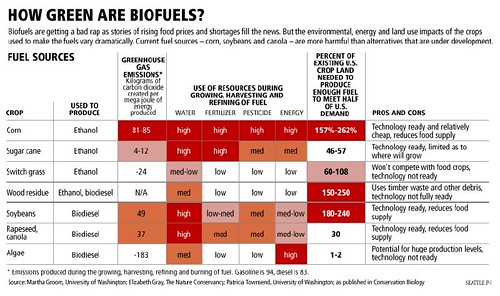FHWA Transportation and Climate Change Newsletter March-April 2011
Prepared by the Office of Planning, Environment and Realty
Federal Highway Administration
FHWA Publishes Transportation Planning for Sustainability Guidebook. Individual states and metropolitan areas have begun to develop policies, programs, and methodologies for improving transportation system sustainability. This FHWA sponsored guidebook examines how sustainability considerations could be better incorporated into transportation planning through case studies identified from a review of sustainability planning practices at state DOTs and from a literature review of US and international practices. HTML version or PDF version (18Mb)
EIA Releases Annual Report on US GHG Emissions. The U.S Energy Information publication, Emissions of Greenhouse Gases in the U.S., reports a 5.8 percent decline in U.S. GHG emissions between 2008 and 2009, the largest yearly decline since the report was first published 18 years ago. Transportation sector CO2 emissions declined for the second year in a row.
Texas A&M Report Examines Integration of Climate Change Adaptation into Transportation Planning. Transportation Planning, Policy and Climate Change: Making the Long-Term Connection reviews research on adapting transportation to climate change, and it discusses Houston-Galveston, Texas as a case study example of trying to incorporate climate change adaptation into transportation planning and decision making. The document is the final report of a research project by TTI’s University Transportation Center for Mobility, funded by a grant from USDOT.
Pew Climate Center Releases Pair of White Papers in Anticipation of Transportation Legislation. As the title suggests, Primer on Federal Surface Transportation Authorization and the Highway Trust Fundgives an overview of federal surface transportation funding. In Saving Oil and Reducing Greenhouse Gas Emissions through U.S. Federal Transportation Policy the authors propose GHG reduction and fuel saving strategies that could be incorporated into new legislation. They highlight implementation options and strategies for overcoming obstacles to inclusion in legislation. The authors also discuss fuel saving and GHG reduction strategies that could be undertaken or expanded under current law. The documents were jointly written by Cindy Burbank of PB and Nick Nigro of the Pew Center.
UK Engineering Academy Reports on Climate Change Adaptation for Infrastructure. Infrastructure, Engineering and Climate Change Adaptation – Ensuring Services in an Uncertain Future, published by the Royal Academy of Engineering, examines vulnerabilities of four infrastructure sectors (including transportation) to the effects of climate change in the U.K. and the modifications that would be needed to increase resilience. It includes an examination of vulnerabilities that arise as a result of interdependencies between different sectors and have the potential to cause cascading failures (for instance, a power failure shutting down rail transport). The study also considers the impact on infrastructure of climate change mitigation efforts and climate induced changes in behavior and demographics.
Transportation Research Record Focuses on Energy and Climate Change. TRB’s TRR Journal number 2191 includes 22 papers on transportation energy and climate change issues. All articles are downloadable for free on TRB’s website.
State and Local News
MTC Releases Vision Scenario Integrating Regional Land Use, Housing, and Transportation Investments to Achieve GHG Reduction Goals. Plan Bay Area – Initial Vision Scenario, was prepared in response to California S.B. 375, which requires regional transportation plans to include a Sustainable Communities Strategy that integrates land use and transportation planning with the goal of reducing GHG emissions. The Initial Vision Scenario identifies a land use development pattern to meet those targets. Using this as a starting point, over the next two years regional agencies will engage local agencies and the public to help identify and assess several detailed Sustainable Communities Strategy scenarios that demonstrate ways that land-use strategies, transportation investments, pricing and other strategies could achieve adopted goals and targets. The scenarios will also address how the Bay Area’s land use plans can assist adaptation to climate change. The final Sustainable Communities Strategy will be incorporated into the area’s 2013 Regional Transportation Plan.
Maryland Releases Phase II of State Adaptation Plan.
Comprehensive Strategy for Reducing Maryland’s Vulnerability to Climate Change Phase II: Building societal, economic, and ecological resilience, includes sector-based adaptation strategies to reduce impacts of climate change. A chapter on population growth and infrastructure identifies potential impacts to the State’s transportation system and identifies strategies for resilience (such as leading by example in development decisions in climate sensitive areas, and strengthening building and infrastructure design standards). It also includes strategies to institutionalize consideration of climate change (such as integrating climate vulnerability data into spatial planning frameworks), and it identifies tools, research and education needed to better inform decisions.
NYSDOT and NYSERDA Select 13 Projects to Promote Reductions in Transportation GHG Emissions. New York State DOT and the private New York State Energy Research and Development Authority joined to provide $1.5 million in funding to 13 organizations and municipalities to advance projects that could lead to GHG emissions reduction in the transportation sector. Projects involve traffic flow improvement/ITS, transportation demand management, electric vehicle fleets, efforts to reduce truck idling, and other efforts.
Announcements
FHWA Seeks Participants for GIS Applications in Climate Change Peer Exchange. This peer exchange is intended for practitioners seeking to share and learn about effective practices, methodologies, and lessons learned in applying GIS to support climate change analysis in transportation. Date and location of the peer exchange have not yet been determined. FHWA is currently seeking potential participants. Practitioners interested in participating in the peer exchange should contact Gina Filosa at 617-494-3452 or by e-mail at Gina.Filosa@dot.gov as soon as possible.
AASHTO Seeks Environmental Research Ideas. AASHTO is soliciting submissions to their Transportation and Environmental Research Ideas database. They will consider input received by April 22nd in their recommendations for research projects to be undertaken by the NCHRP. Last year, AASHTO used the TERI database to put forward eighteen research ideas for funding through NCHRP, including thirteen ideas for the quick turnaround, environmentally-focused NCHRP “25-25” program (research that can be completed in less than one year and under $100,000) and five ideas for funding as full-scale NCHRP projects, which typically range from $200,000 to $750,000 and take two to three years to complete. Four of the full-scale NCHRP projects and eight of the 25-25 studies were selected for funding. You can submit your research ideas directly though the TERI database. On the webpage you will find a template for submitting research ideas, please be sure to include a clear title, a detailed scope and information about the approximate timeframe and budget.
FHWA Webinar to Highlight Sustainable Pavements. On Earth Day, April 22, from 11:00-12:00 Eastern, FHWA is hosting a free webinar on in-place recycling of highway pavements, “Sustainable Environment – Putting EARTH DAY Into Practice on Our Nation’s Roads and Highways”. Registration is free and open to everyone.
FHWA Holding Series of Webinars on Congestion Pricing. The FHWA Offices of Operations and Innovative Program Delivery have launched a new webinar series, entitled “Overcoming the Challenges of Congestion Pricing.” These webinars are aimed at state and local agencies that are currently in the process of implementing or would like to implement congestion pricing; decision-makers/political leaders who want to better understand the benefits of congestion pricing; MPOs that may be interested in incorporating pricing into their planning activities; and others who just want to learn more about congestion pricing strategies. Congestion pricing strategies can often have a co-benefit of reducing GHG emissions. Registration is free and open to everyone who is interested.
Webinar Schedule – April 2011
- April 14, 2011 2:00 – 3:30 pm ET – Congestion Pricing Benefits, Challenges and Opportunities
- April 19, 2011 2:00 – 3:30 pm ET – Institutional Issues in Congestion Pricing
Webinar Schedule – May through December 2011 (dates are tentative and subject to change)
- May 26 – Congestion Pricing Equity Impacts
- June 23 – Technology to Enable and Complement Congestion Pricing
- July 28 – Integrating Transit with Congestion Pricing and Increasing Congestion Pricing Acceptance
- August 25 – Economics of Congestion Pricing and Impacts on Business
- September 22 – Best Practices in Parking Pricing
- October 27 – Dynamic Ridesharing and Congestion Pricing
- November 17 – Pay-as-You-Drive Insurance
- December 15 – Results of the Urban Partnership and Congestion Reduction Demonstration Programs.
Reminders
2011 Transportation Planning, Land Use, and Air Quality Conference, May 9-10. TRB is cosponsoring the 2011 Transportation Planning, Land Use, and Air Quality Conference on May 10-11, 2011, in San Antonio, Texas. The conference will explore the latest research on integrating transportation planning, land use decisions, and improving air quality. The spotlight theme for the conference will be Integrating Transportation, Land Use, and Air Quality to Meet Sustainability and Livability Objectives. For more information see: http://www.ucs.iastate.edu/mnet/tpluaq/home.html
If you have any suggestions for inclusion in future issues of Transportation and Climate Change News, or if someone forwarded this newsletter to you and you’d like to receive it directly in the future, please send your suggestions or request to Becky Lupes at Rebecca.Lupes@dot.gov.













